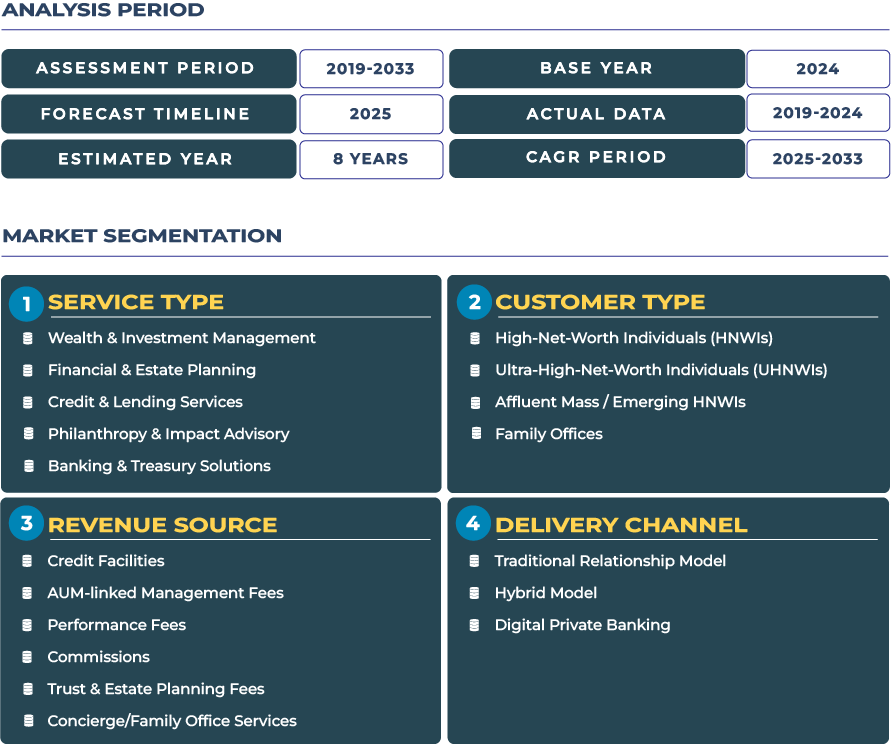Canada Private Banking Market Outlook: Resetting Foundations and Unlocking New Growth Opportunities in the Canadian Private Banking Sector
In an era where the notion of “zero” underscores a fresh reset of business models and client expectations, the Canadian private banking ecosystem is entering a pivotal phase. The Canadian private banking market is forecast to grow from approximately USD 27.6 billion in 2025 to around USD 45.0 billion by 2033, representing a CAGR of about 6.3% for the period 2025-2033. This trajectory highlights that while the market base is smaller than larger global peers, the growth potential is disproportionately high-making Canada a strategic theatre for private banking innovation.
Note:* The market size refers to the total revenue generated by banks through various services.
For Canadian private banks and wealth managers, the zero-theme signals a moment to rebuild from foundational elements: redefining the integrated wealth-ecosystem model, embracing digital-first and advisory-rich propositions, and aligning with the evolving high-net-worth individual (HNWI) expectations. With macroeconomic volatility, geopolitical uncertainty, pandemic legacy effects, and complex cross-border flows all shaping the affluent cohort’s outlook, the Canadian private banking industry must transition from offering discrete services to orchestrating seamless deposit-to-treasury pathways for clients.
Growth Engines & Restraints: What Powers and What Slows Canada’s Private Banking Ascent
Drivers of growth. A primary growth engine is the rise in Canadian household wealth, especially among affluent clients whose portfolios increasingly include multiple properties, business interests, cross-border investments and complex tax estates. As the Royal Bank of Canada notes, “wealthy Canadians typically have more complex financial pictures and they can benefit from private banking services, including estate planning.” This complexity drives demand for investment services, trust and estate advisory, embedded insurance/bancassurance, and treasury-based solutions. Secondly, immigration flows and global mobility are increasing the number of UHNWIs in Canada, thereby expanding the addressable pool. Thirdly, technology adoption among Canadian private banks-while not at global leading pace-has accelerated the integration of digital advisory, payments, and liquidity-management modules into the private banking value chain.
Restraints on growth. Key constraints include regulatory rigidity and compliance burdens, which create higher cost bases and slower time-to-market for new private banking products. Interest-rate fluctuations and macroeconomic headwinds may suppress client risk appetite or retract lending growth. The relatively smaller scale of the Canadian market compared to U.S. or European peers means that scale economics are harder to achieve, making margin expansion more challenging. Additionally, non-bank wealth-tech platforms and cross-border fintech entrants are increasingly targeting Canadian affluent clients, intensifying competitive pressure and requiring private banks to reinvent rather than iterate their service models.
Trendlines & Opportunity Zones: Digital Wealth, ESG Imperatives and Regional Affluent Clusters
Major trends emerging. One of the most significant trends in the Canadian private banking market is the turn toward digital-wealth platforms. Affluent clients expect integrated platforms covering investment services, payments, real-time credit decisions and treasury-optimised solutions delivered through an omni-channel experience. A second trend is the rise of ESG and sustainability in private wealth propositions: Canadian high-net-worth families increasingly demand purpose-driven investment, philanthropic advisory and sustainability-linked lending products. Thirdly, cross-border wealth flows-particularly within the U.S.–Canada corridor-are growing, forcing private banks to offer global service models with local execution.
Key opportunity areas. Private banking firms can seize opportunity by developing alternative-investment access (private equity, real estate, venture capital) specifically tailored for Canadian wealthy clients wanting diversification beyond standard portfolios. They can also embed payments and treasury services into the wealth journey-allowing deposit liquidity, lending structures and cross-market payments to be managed through a unified platform. Regionally, affluent clusters in Vancouver, Toronto, Calgary and Montreal represent strong growth hubs: for example, the immigration and tech-sector draw in Vancouver and Toronto expands the millionaire segment. Firms that localise service models to these hubs while offering global reach will be best positioned.
Competitive Landscape: Strategic Advances Shaping Canada’s Private Banking Sector
Competitive intensity in the Canadian private banking market is escalating. Leading institutions such as Bank of Montreal (BMO) have been recognised for their private banking capabilities-a June 23 2025 announcement saw BMO named Best Private Bank in Canada for the 15th consecutive year. At the same time, global institutions are targeting the Canadian market aggressively: for example, HSBC Holdings plc plans to double its Canadian private client base over the coming years, citing Canada as “a low-risk environment with a stable economy that is attracting wealth and quality immigrants.”
In response, Canadian private banks are deploying differentiated strategies: segmentation of ultra-HNW vs next-gen affluent, platform consolidation of services (investment, lending, payments, insurance, treasury) and partnerships or acquisitions to boost capabilities in alternative investments and cross-border advisory. For instance, in May 2025, Scotiabank announced an arrangement with ICICI Bank Canada to offer wealth management to high-net-worth clients. The competitive battle is increasingly about embedding integrated service ecosystems-combining deposit/credit flows, payments, investment advisory and insurance-rather than just offering standalone wealth management. Private banking firms that neglect this shift risk being displaced by digital entrants or global firms with scaled platforms.







